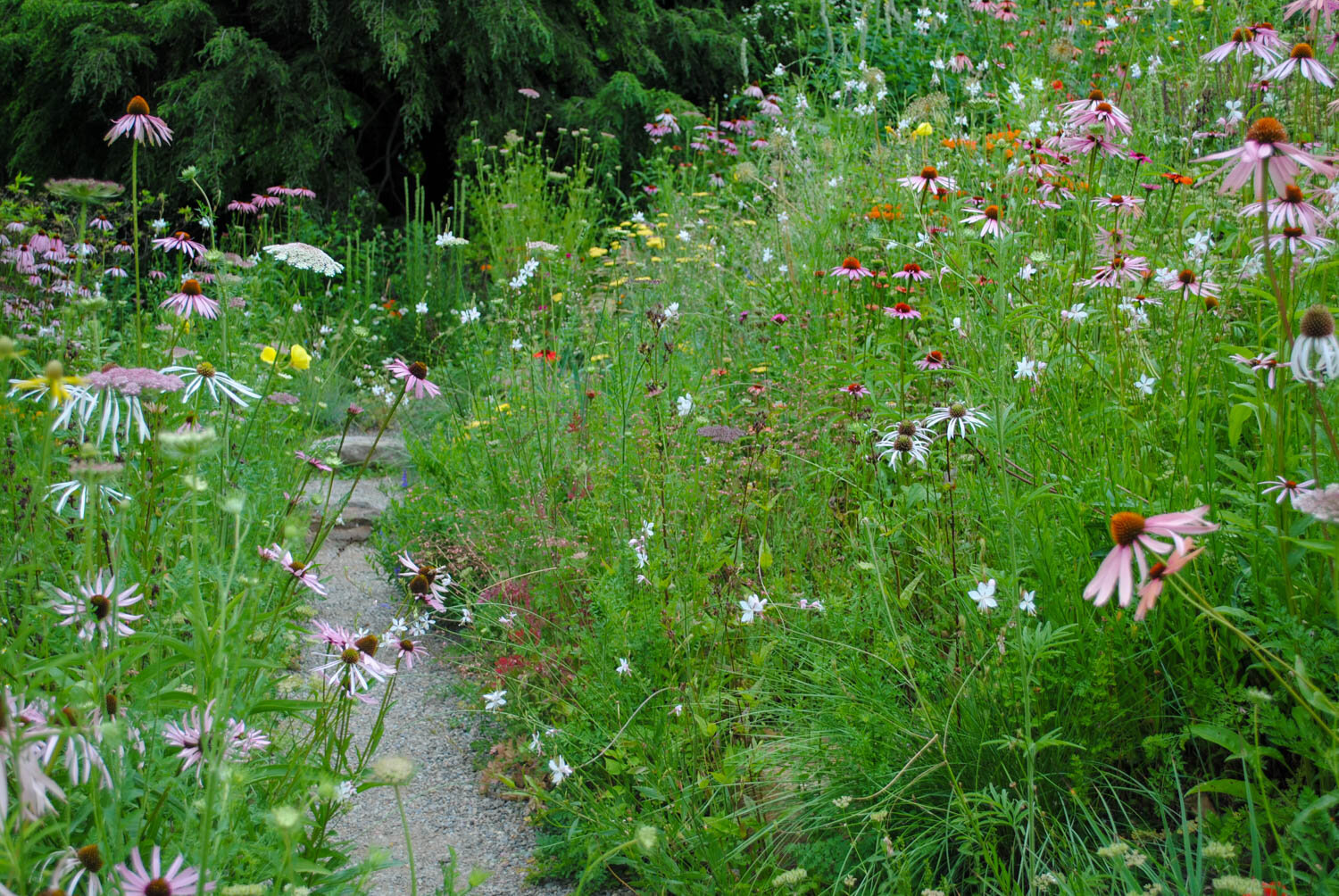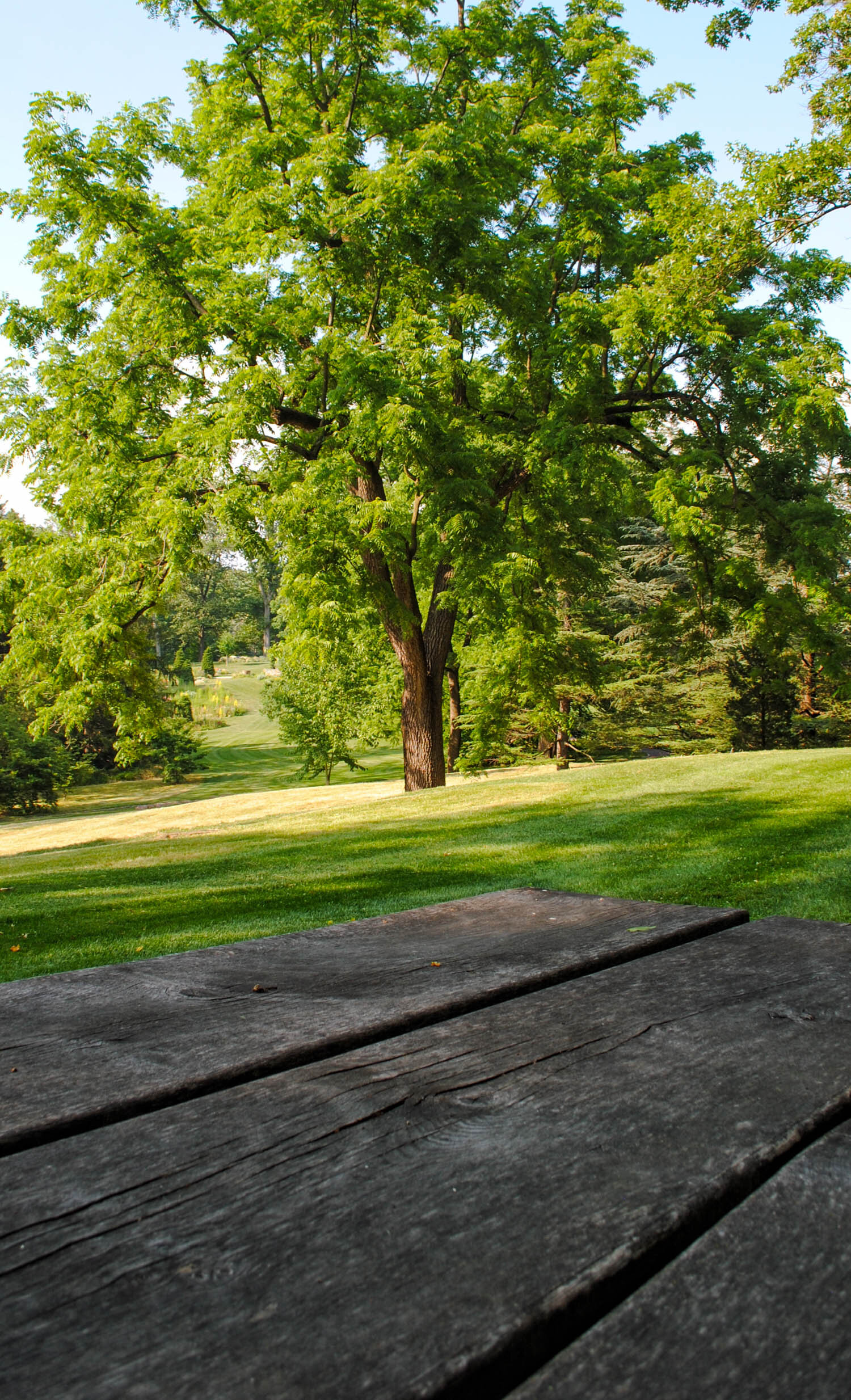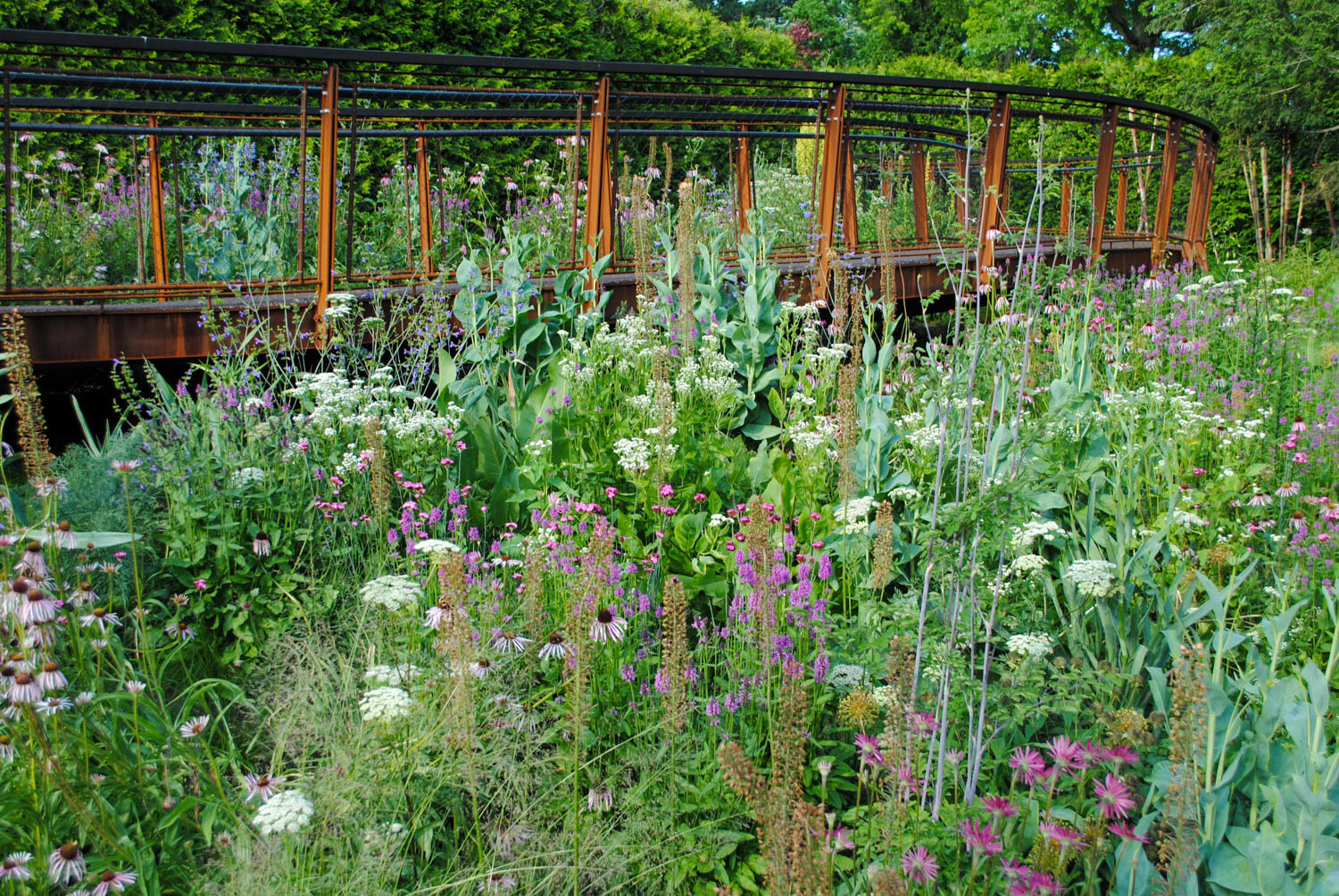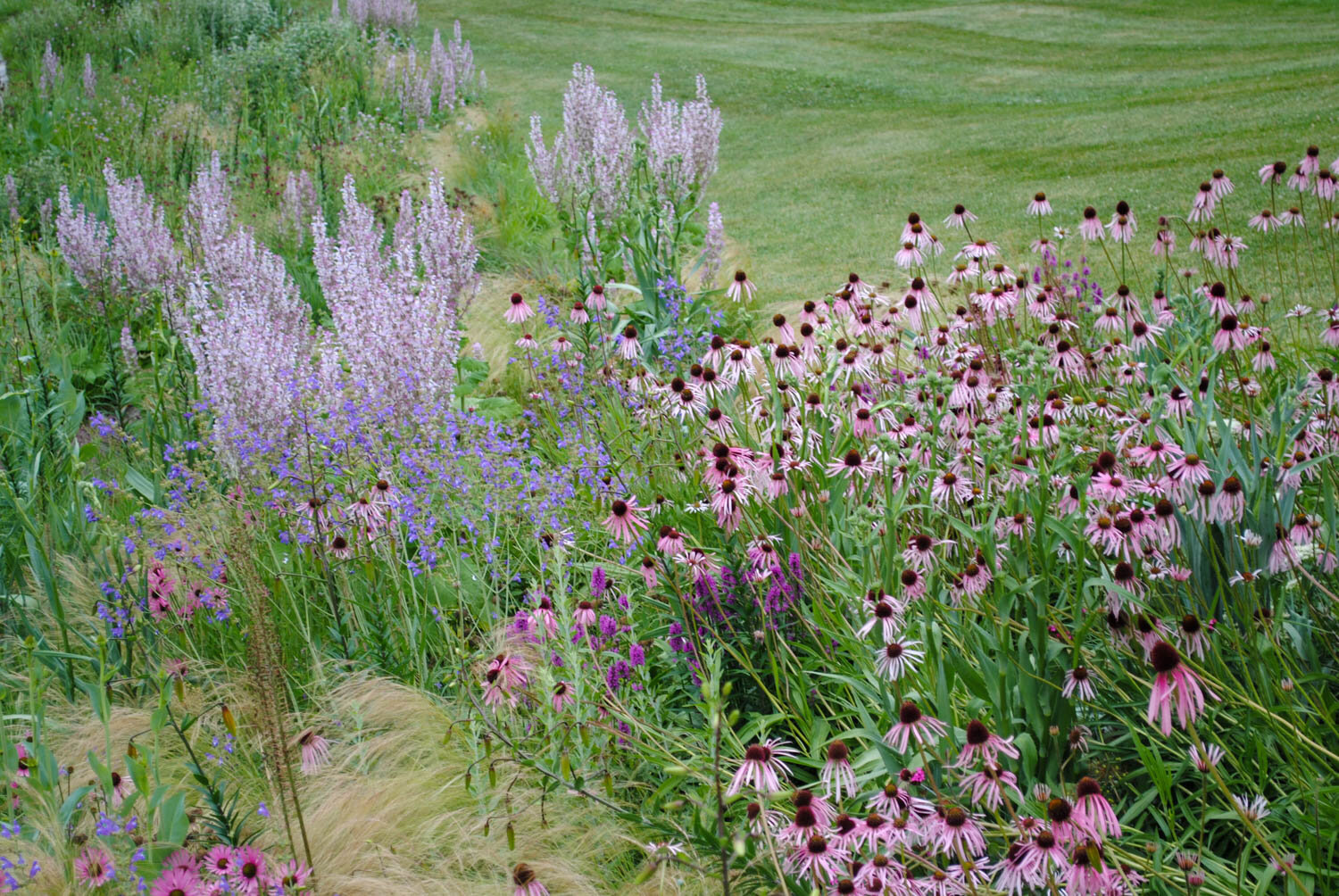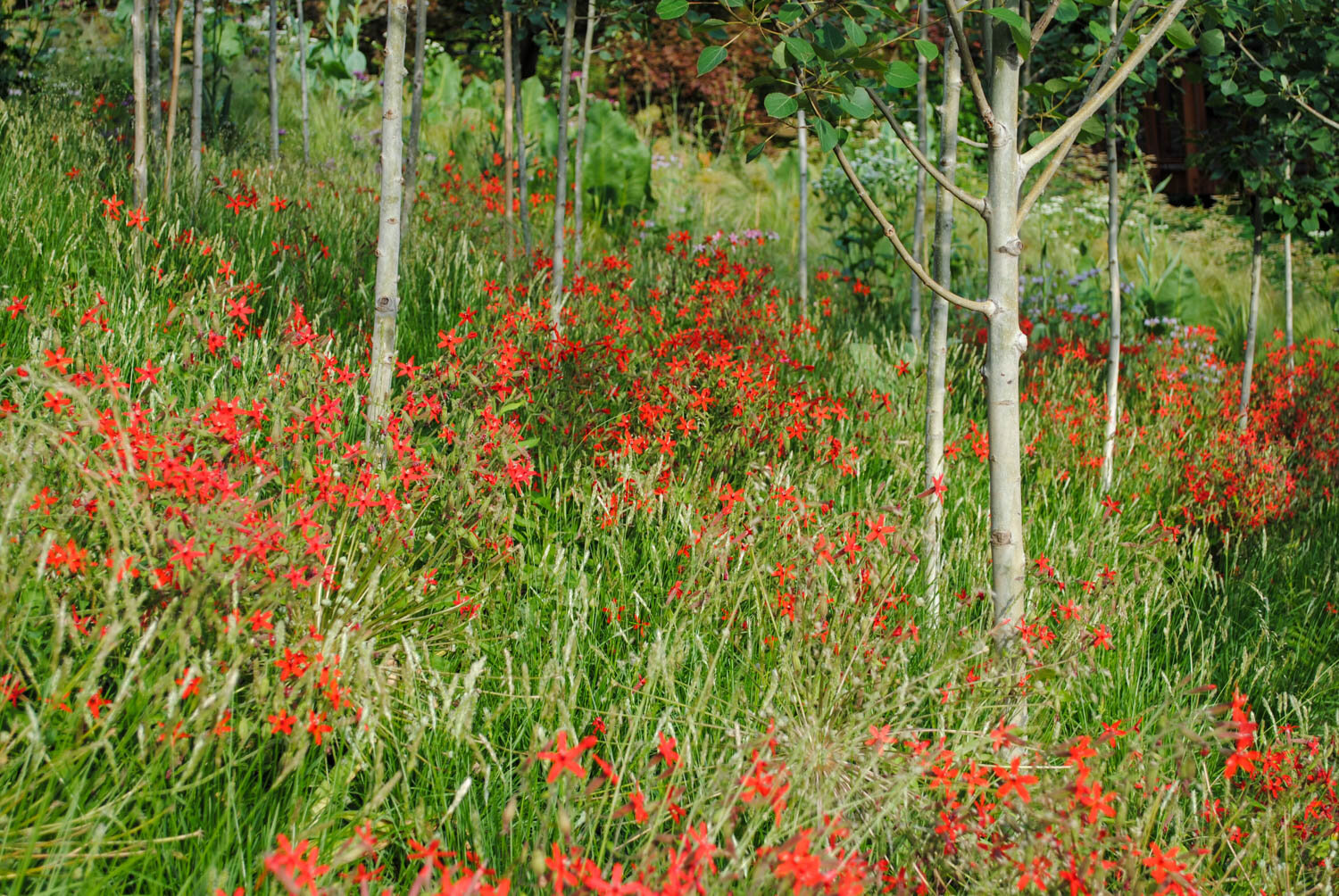This post is the third and final post in a series on guest gardening at Chanticleer. Reflections on the first day can be found here and reflections on the second day here.
Day 3, Wednesday 22 June 2016
My last day guest gardening at Chanticleer I spent the morning with Joe Henderson. I have known Joe since I interned at The Scott Arboretum in Swarthmore, PA in 2008, and it was great to catch up with him and hear his rich perspective on gardening. Joe is an incredible gardener and artist; his media not only includes plants but also metal and glass as he once apprenticed as a jeweler. He helped make several ornate pieces at Chanticleer like the front fence and gate and the handrail up near the house.
Joe Henderson, a man outstanding in his planting
We started at the rock ledge, a beautiful wildflower planting that connects the gravel garden with the pond below. A narrow gravel path winds through this wildscape. Joe talked about how all the space in a garden matters and how he strives for multilayer interest by planting through time. He said he once did a presentation on a small part of the garden and how he worked that area to get as much out of it as he could. For example, he planted snowdrops for color in late winter, ferns for interest in spring, and then colorful perennials for summer through autumn.
Looking down on the rock ledge at Chanticleer
At the base of the rock ledge one looks out onto the ponds at Chanticleer. Only one is visible from this angle.
Daucus carota and other plants catch the morning light on the rock ledge.
A gravel path winds down the rock ledge so that visitors can immerse themselves in the planting
Part of making the garden perform is that his beds are packed with plants. He enjoys the ever changing nature of the garden and noted that it doesn’t matter what happens with the plants as long as the appearance is nice. Joe gives the garden free domain and unless what he sees is bad, he works with it. He noted that sometimes the less you know the better because rules and norms in horticulture confine you. Joe also shared the wisdom with me that he is never going to make everyone happy. If he likes the planting, he is happy.
Joe Henderson’s approach to gardening employs the management style over maintenance. He is not interested in preserving a planting as it is. No, he embraces change and steers it as needed.
But, to create a sense of order in his plantings, Joe said he focuses on designing with color and color schemes. He searches for colors and considers intricate details of even something like the color green. He asked, “What color green is it? Red, blue, yellow, etc.” Paying attention to such details allowed the garden to feel more intimate and connected.
Notice how this planting of pink Papaver and the golden Pleioblastus near the ponds echoes the pink Tamarix and yellow Verbascum olympicum up on the rock ledge. Attention to such details with color create harmony and repetition in a planting, even though the plants are different.
Note how the salmon-colored Echinacea in the background helps combine the orange Asclepias tuberosa and the pink Echinacea tennesseensis.
I asked Joe about his approach to new plantings. He said he takes inspiration in the patterns of how plants appear in the wild and their natural distributions. Then, he emulates nature while taking advantage of horticulture minutiae of space, light, color, texture, foliage, and drifts. When adding plants on the rock ledge, he tried to tie his planting together with other parts of the garden using color since it can be seen from a distance. He talked about tying together his rock ledge with the elevated pathway and how he planted more pink and purple in the rock ledge to connect the two spaces. He said once he has a design, he plots out plants in a grid. On the grid, there is a dot everywhere that a plant occurs. He puts that species out and then goes back and repeats for other species.
Verbascum olympicum occur singly or in very small groups in nature. If we crammed hundreds in here, it wouldn’t look right. (By the way, I use this image in my classes to help teach this concept of looking to nature for inspiration.)
Echinacea planted on the rock ledge. In nature, Echinacea tend to occur in larger groups of ten-to-twenty individuals. That’s why you need to plant more Echinacea in your garden!
Joe took me up to the far southwest hillside past Asian woods and we turned and looked back at the rock ledge that was about 500 feet away. I could still make out the Verbascum spears in the distance. He showed me how at Chanticleer they have been working on creating vistas. The idea is that these long views make a place feel bigger and yet more intimate because it appears all connected together. Had one not already visited the rock ledge, just walking up here and seeing something in the distance would encourage exploration. This vista was one, but others including the view from the house and elevated walkway were also important.
I put two of these photos into this post showing the vista from the picnic table. One so you can appreciate the distance…
… and the other so that you can see the detail more clearly on the rock ledge and gravel garden. Having such views makes the garden feel larger and yet more intimate.
And, I couldn’t wrap up this discussion on Joe’s part of the garden without showing this lovely sitting area down near the ponds.
Just look at how simple these bamboo strips demarcate the path.
After a great morning with Joe, I met up with grounds manager Jeff Lynch around lunch. Jeff and I first met when I keynoted at the New York Botanical Garden the previous year, and during this trip our friendship really grew. I came to realize that we were both organic farming enthusiasts and shared many views on enriching soil for plants. I was so excited to learn about their O2 composting system they had built at Chanticleer.
Jeff Lynch discusses the O2 composting system at Chanticleer. In the background is Nate Pinelli who oversees the composting at Chanticleer. Nate gives a rough scale of the size of their huge compost bins.
The O2 composting system forces air into the compost pile using a greenhouse fan and drilled pipes under the pile. This oxygenation allows them to heat the pile based on how often air is introduced into the compost, and it removes the need for turning, which can be an issue in small spaces with large amounts. Jeff also said they introduced a small amount (~5% by volume) of biochar into the compost. Jeff noted that biochar that goes directly into the soil can make nutrients unavailable. With my background in soil science, I assume that putting it in the compost first fills those binding sites with nutrients.
Nate Pinelli managed the compost, and he kept detailed records on temperatures and time. Jeff mentioned how ardent they were about making sure that only organic matter went into the bins as soil and soil mix were too stable. Once filled, they cap it with old compost and cover the bins with compost fleece that allows air in but not moisture. That way, they can control how much water enters the pile, too. Once mature, they would sift the material and use it in the garden. I was blown away seeing this simple yet creative system.
Fresh material goes into the compost piles.
Here you see a box housing the greenhouse fan and piping that leads to the bins. Note that some of the pipes in this photograph have been pulled out because those bins are not currently active.
I saved one of my favorite plantings from my time at Chanticleer for last—the elevated walkway. When I was there in 2016 the planting and pathway was roughly 1 year old, and I so appreciated the design and thought that went into making it amazing. In mid-June it was a floral explosion.
Jeff and I walked the elevated pathway later my last day discussing how the design went through several iterations before planting and how the staff had prepared the ground after construction using augers and air spades to get the soil just right. Jonathan Wright had done the design for the planting. The top of the walkway was planted with an open prairie habitat that faded into edge habitat and finally into woodland. While some plants were the same as I had seen just hours earlier on the rock ledge, the blues and grays created more of a cool-color scheme.
I loved seeing several of my favorite plants integrated together. Color echoes abounded. The glaucous foliage of Rudbeckia maxima and Eryngium yuccifolium. The mauve-to-pink Salvia sclarea and Echinacea species. The fading Allium with Nassella tenuissima. And, then you had things that just popped out like the massive leaves on Silphium terebinthinaceum or the crimson Silene virginica glowing under the quaking aspens from the setting sun. During my three-day guest gardening stint, I kept finding myself returning to this spot in different light and at different times of the day to appreciate its beauty.
The elevated walkway with porous pavement winds through this diverse perennial planting at Chanticleer. The rusted steel is such a good neutral, earthy color to go with this planting.
Another dazzling display near one of the landings on the elevated walkway at Chanticleer where visitors can pause and rest.
Here’s the view looking down from the upper landing onto the hillside. Notice how your eye flows through the planting.
The rosy-colored Echinacea species and Salvia sclarea create a good color combination.
Here we begin to approach the woodland. I love how massive those Silphium terebinthinaceum leaves are. Note the color echo between the fading Allium seed heads and the Nassella tenuissima.
I enjoyed these fading Allium schubertii infructescences along the elevated walkway.
I love how full and layered this photograph shows this elevated walkway planting to be.
The floor under these Populus tremuloides is lit with Silene virginica.
So, there you have it. Three incredible days of guest gardening at Chanticleer. If I’m honest, I have been trying to write about my experience for the past four years since my visit. I would start and stop only because I felt it hard to describe three perfect days in one of the best gardens with some of the finest horticulturists I know. And, it is funny because as I have gone through photographs and notes, I see many threads of knowledge that I gleaned during my time at Chanticleer that I’m already applying. I weave experiences I had not only into my own garden but also into stories and inspiration for my students and for my greater learning audience out there.
So, in case you haven’t picked up on it yet, if you’re ever in the Philadelphia area, take a day or two (or three!) and visit Chanticleer. It will enrich your gardening soul.
I hope that you enjoyed my reflections from my three days guest gardening at Chanticleer.




